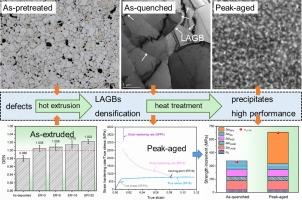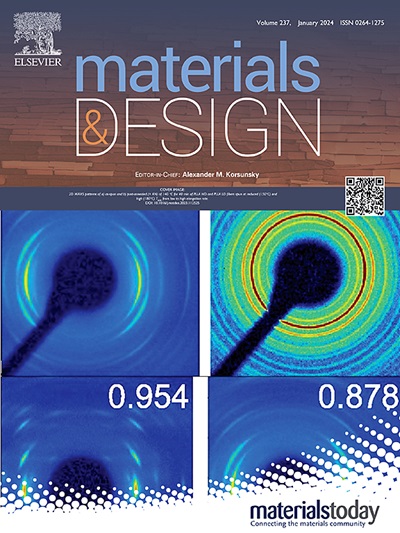抑制缺陷诱发的塑性不稳定性,实现喷射成型 7050 铝合金优异的强度-电导率组合
IF 7.6
2区 材料科学
Q1 MATERIALS SCIENCE, MULTIDISCIPLINARY
引用次数: 0
摘要
本研究旨在通过热挤压和后续热处理提高喷射成形(SFed)7050 铝合金的强度和延展性。研究了这些过程中的微观结构和机械性能演变。研究发现,SFed 7050 铝合金因各种缺陷(如平均尺寸为 7.6 μm、面积分数为 3.7 % 的气孔)而导致的低致密性可以通过热挤压得到显著提高,甚至达到接近理论密度的水平。在这一过程中,晶粒沿挤压方向由等轴形转变为细长形,晶粒明显细化,呈现出强烈的纤维纹理。与已报道的铝合金相比,SFed 7050 铝合金在适当热处理后的挤压比超过了 16,实现了更优越的强度-电导率组合。所取得的高性能应归功于晶粒细化、质地坚固和高致密性,它们抑制了缺陷引起的塑性不稳定性。此外,热挤压和热处理的结合为提高 SFed 7050 Al 合金的强度和延展性提供了有效途径。本文章由计算机程序翻译,如有差异,请以英文原文为准。

Suppress defect-induced plastic instability to achieve superior strength-ductility combination of spray formed 7050 Al alloy
This research aimed to enhance the strength and ductility of spray formed (SFed) 7050 aluminum (Al) alloy through hot extrusion and subsequent heat treatment. Microstructure and mechanical properties evolution during these processes were investigated. It was found that the low densification of the SFed 7050 Al alloy due to various defects such as pores, with an average size of 7.6 μm and an area fraction of 3.7 % could be notably enhanced by hot extrusion, even achieving a level close to theoretical density. This process led to a transformation of grains from equiaxed to elongated shapes along extrusion direction and significant grain refinement, exhibiting a strong fiber texture. While the employed extrusion ratio exceeds 16 with proper heat treatment, the SFed 7050 Al alloys achieves superior strength-ductility combination compared with reported Al alloys. The achieved high performance should be attributed to the grain refinement, strong texture and high densification that suppress defect-induced plastic instability. Furthermore, the combination of hot extrusion and heat treatment, provides an effective way to enhance strength and ductility for SFed 7050 Al alloy.
求助全文
通过发布文献求助,成功后即可免费获取论文全文。
去求助
来源期刊

Materials & Design
Engineering-Mechanical Engineering
CiteScore
14.30
自引率
7.10%
发文量
1028
审稿时长
85 days
期刊介绍:
Materials and Design is a multi-disciplinary journal that publishes original research reports, review articles, and express communications. The journal focuses on studying the structure and properties of inorganic and organic materials, advancements in synthesis, processing, characterization, and testing, the design of materials and engineering systems, and their applications in technology. It aims to bring together various aspects of materials science, engineering, physics, and chemistry.
The journal explores themes ranging from materials to design and aims to reveal the connections between natural and artificial materials, as well as experiment and modeling. Manuscripts submitted to Materials and Design should contain elements of discovery and surprise, as they often contribute new insights into the architecture and function of matter.
 求助内容:
求助内容: 应助结果提醒方式:
应助结果提醒方式:


